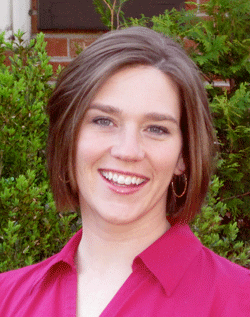From classroom to patient care: EPI/BIO principles at work to improve healthcare
April 2, 2010

Anna Cass
Arnold School of Public Health student Anna Cass has a PhD dissertation coming up where she’s going to expand on one of the hottest topics in the public health realm - the tide of hospital-acquired infections (HAIs) that kill some 99,000 Americans annually.
Apart from the human toll, HAIs cost between $35.7 to $45 billion in healthcare expenses annually, according to the U.S. Centers for Disease Control and Prevention.
Cass, who is pursuing her doctorate in epidemiology, has been researching issues surrounding HAIs at the Greenville Hospital System (GHS), which is seeing increasing collaboration with the University of South Carolina and the Arnold School of Public Health.
Thanks to the USC/GHS relationship, Cass has been able to make a home for her family in Greenville, where her husband Jeremy is a member of the Furman University faculty. Both Casses attended Furman as undergraduates where Anna earned degrees in Spanish and health and exercise science.
Both Casses attended the University of Kentucky, where Anna learned she had a knack and a passion for epidemiology.
“The appeal to me was learning the skill set -- the ‘epidemiology toolbox’ we use to solve problems. With epidemiology you don’t have to be married to one particular public health issue all your career,” she said.
With EPI/BIO department head Dr. Robert McKeown as her adviser, Cass has been working as a biostatistician in the GHS Quality Management Department under the direction of Arnold School alumna (2001) Dr. Dawn Blackhurst. Jennifer Davis, another Arnold EPI/BIO doctoral student, works in the same office.
Her studies have helped Cass learn how to apply principles of epidemiology and biostatistics to improving the quality of care in a hospital setting.
She’s observed firsthand how infection-control personnel have struggled, not only to develop ways to control HAIs, but also to teach the same procedures to doctors and nurses.
The mission has become more complicated since 2008 when the State Legislature started requiring hospitals to report certain infection rates to the S.C. Department of Health and Environmental Control (DHEC) and the public.
South Carolina is among 27 states that now require public reporting of hospital-acquired infection rates, which in the abstract appears to be a worthy goal.
But in reality, simply collecting data for public dissemination is, at least in South Carolina, an unfunded mandate that taxes the time of caregivers and may not fully inform the public, Cass said.
There is a potential danger to simply report numbers without some interpretation based on good epidemiology, she said.
“With HAI reporting, we are communicating rates and measures to the general public, not a public health audience, so it’s all the more important to to make sure we provide information that isn’t confusing or misleading,” Cass said. “There are so many subtleties that play into the numbers -- like risk adjustment -- to enable comparison between a teaching hospital and small, rural hospitals.”
Blackhurst said the HAI reporting effort “remains a work in progress. We worked with DHEC and the CDC to report the data in a way that is most understandable to the public and fairest to the hospitals that care for the sickest patients.”
For Cass, her dissertation defense is proof that her Ph.D. journey, which she began fulltime in 2004, is coming to a close. Even with her expertise in numbers, Cass found her academic schedule faced two significant interruptions.
“Their names are Addy and Charlie,” she laughs, referring to daughter Adalene, age 3, and son Charlie, 16 months.



_01.jpg)
_02.jpg)